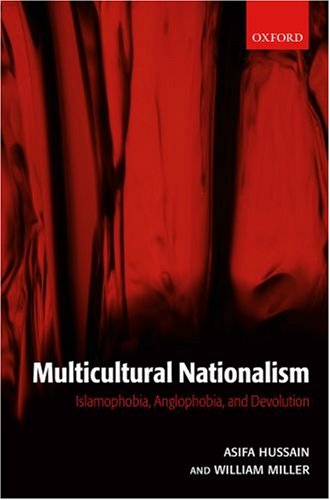

Most ebook files are in PDF format, so you can easily read them using various software such as Foxit Reader or directly on the Google Chrome browser.
Some ebook files are released by publishers in other formats such as .awz, .mobi, .epub, .fb2, etc. You may need to install specific software to read these formats on mobile/PC, such as Calibre.
Please read the tutorial at this link: https://ebookbell.com/faq
We offer FREE conversion to the popular formats you request; however, this may take some time. Therefore, right after payment, please email us, and we will try to provide the service as quickly as possible.
For some exceptional file formats or broken links (if any), please refrain from opening any disputes. Instead, email us first, and we will try to assist within a maximum of 6 hours.
EbookBell Team

0.0
0 reviews
ISBN 13: 9780199280711
Author: Asifa M Hussain, William L Miller
When the focus is on black or Asian minorities, Britain is frequently described as a multi-cultural state. But when the focus is on Scotland, England and Wales, Britain is also described as a multi-national state. Yet debates about multiculturalism and nationalism have been held in parallel without sharing even a common vocabulary. This book is a pioneering study of how multiculturalism interacts with multinationalism, especially within post-devolution Scotland. It gives equal attention to Scotland's largest 'visible' and 'invisible' minorities: ethnic Pakistanis (almost all of them Muslim) and English immigrants. Rising Scottish self-consciousness could have posed a challenge both these minorities. But in practice, potential problems have proved themselves to be solutions, integrating rather than alienating. In the eyes of the minorities, devolution has made Scots at once more proud and less xenophobic. Even English immigrants feel devolution has defused tensions, calmed frustrations, and forced Scots to blame themselves rather than others for their problems. Pakistanis have suffered increasing harassment - but they attribute that to 9/11 not to devolution. And Muslims adopt Scottish identities, Scottish attitudes, even Scottish nationalism - consciously or unconsciously using these as tools of integration. The book is based in part on large-scale surveys: of Pakistani and English minorities within Scotland, and of the majority populations in Scotland and England. But it is also based on systematic analysis of transcripts of focus-group discussions with minorities revealing the variety of opinion within minorities as well as the contrasts between them. In particular, it presents a unique account of how Scottish Muslims express their feelings in a time of crisis.
1. Multicultural Nationalism
1.1 Nationalism—Ethnic, Civic, Multicultural
1.2 Identity—‘Being’, ‘Choosing’, ‘Using’
1.3 Two Minorities
1.4 The Setting—A Peculiar Nationalism, a Peculiar Multiculturalism, a Peculiar Time
1.5 Plan of the Book
2. What Is Best and Worst about Scotland
2.1 What Is Best and Worst about Britain
2.2 What Is Best and Worst about Scotland
2.3 Scotland in Comparison
2.4 Crossing the Border
2.5 Conclusion: The Wrong Stereotypes
3. Islamophobia—In England and Scotland
3.1 The ‘Death of Multiculturalism’ and the Growth of Islamophobia
3.2 Measuring Street-Level Islamophobia
3.3 Social Foundations of Islamophobia
3.4 Cultural and Political Foundations of Islamophobia
3.5 A Multivariate Comparison of Islamophobia in Scotland and England
3.6 Conclusion: Islamophobia and Sub-State Nationalisms
4. The Auld Enemy
4.1 Scottish Phobias: The Displacement Thesis
4.2 Measuring Five Scottish Phobias
4.3 The Social Foundations of Scottish Phobias
4.4 The Cultural and Political Foundations of Scottish Phobias
4.5 A Multivariate Comparison of Anglophobia and Islamophobia in Scotland
4.6 How Scottish Phobias Stack Up
4.7 Conclusion: Less Phobias or Different Phobias?
5. Eyes Wide Open
5.1 How Minorities Attribute Prejudice
5.2 Accuracy, Inaccuracy, and Denial
5.3 Background or Experience: The Foundations of Phobia-Perceptions
5.4 Conclusion: Phobias Come from within, Phobia-Perceptions from Outside
6. Harassment, Discrimination, Abuse
6.1 Claiming Rights, Accepting Duties
6.2 Perceptions of Discrimination
6.3 Experience
6.4 Coping
6.5 Explaining Conflict Perceptions
6.6 Conclusion: More Integration, More Harassment?
7. History, Culture, Symbols
7.1 History: Inherited or Manufactured
7.2 Culture: Whose Culture?
7.3 Symbols: Flag, Venue, Presence
7.4 Cultural Divisions
7.5 Conclusion: Adapting to Scotland or Adapting Scotland
8. Identity and Identifying
8.1 Multiple Identities: Nested, Hyphenated, Flexible, and Instrumental
8.2 The Limits of Flexibility: Primary and Secondary Identities
8.3 Influences on Identity
8.4 Political Consequences of Identity
8.5 Conclusions: Bridges and Walls
9. After Devolution: Parliament and People
9.1 The Parliament: Performance and Style
9.2 The Parliament: Both Inclusive and Exclusive
9.3 The Street-Level Consequences of Devolution
9.4 The Street-Level Impact of Concurrent Events
9.5 A Future in Scotland
9.6 Conclusion: Multicultural Nationalism within a Multinational State
References
multicultural nationalism as an ethics of social membership
question about nationalism
exclusive nationalism examples
cultural nationalism vs civic nationalism
nationalism and multiculturalism
us multicultural society
Tags: Asifa M Hussain, William L Miller, Multicultural, Nationalism